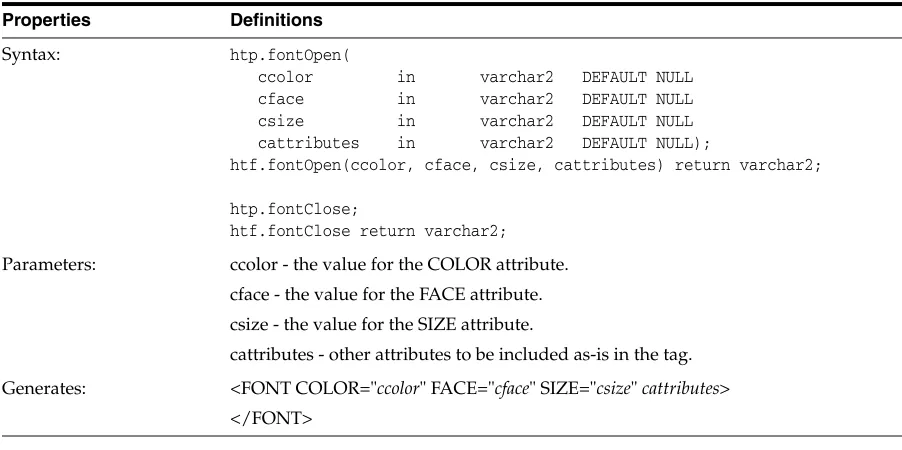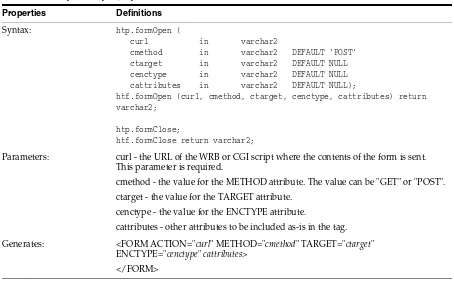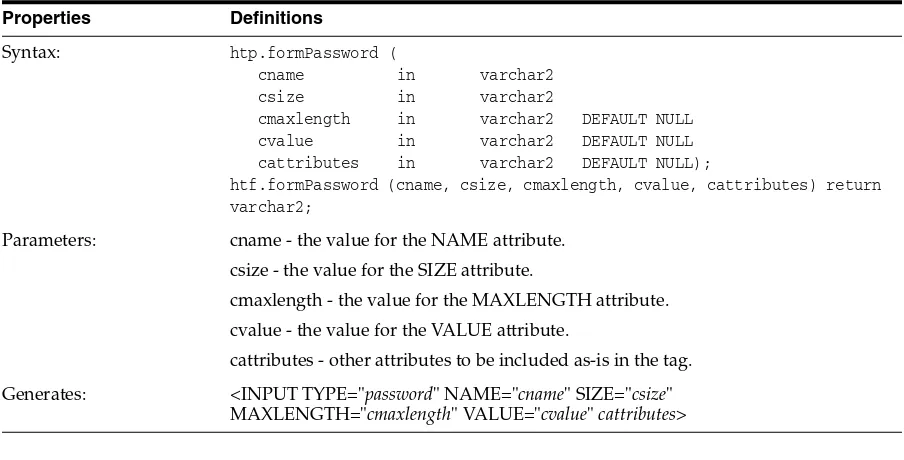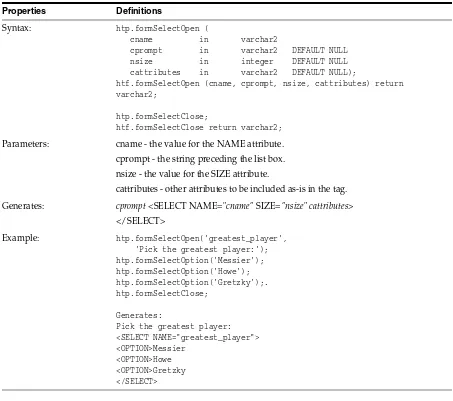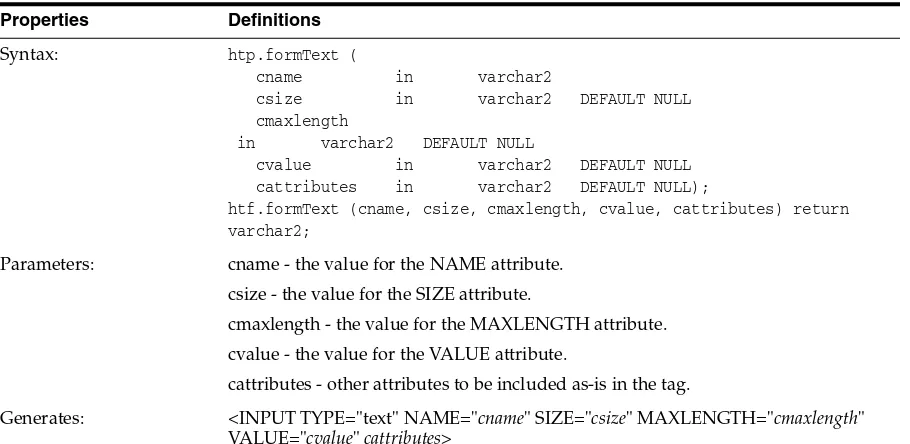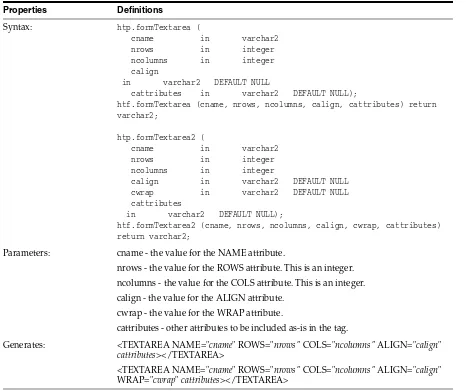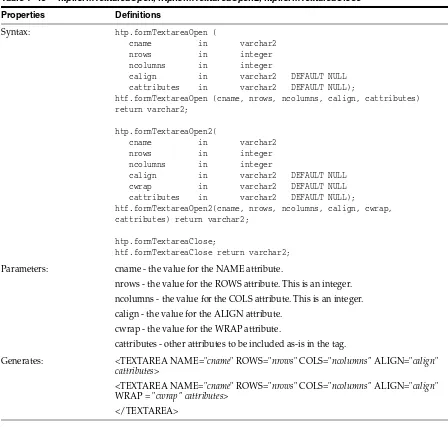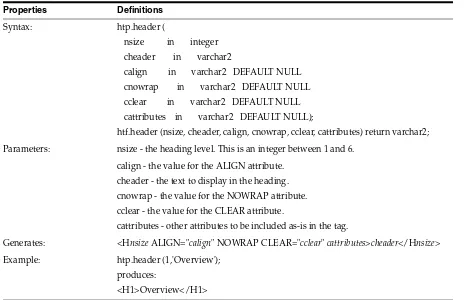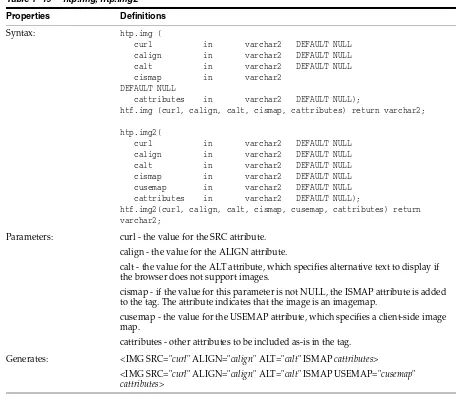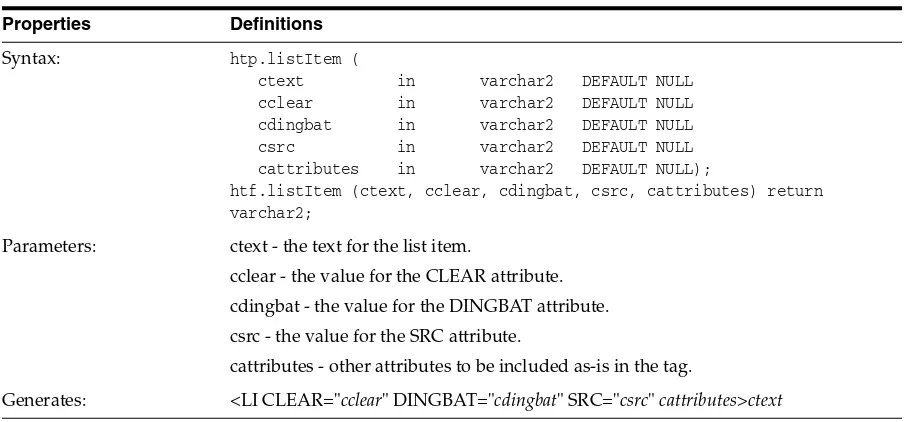Oracle® Fusion Middleware
PL/SQL Web Toolkit Reference
11
g
Release 1 (11.1.1)
E12042-01Oracle Fusion Middleware PL/SQL Web Toolkit Reference, 11g Release 1 (11.1.1) E12042-01
Copyright © 1996, 2009, Oracle and/or its affiliates. All rights reserved. Primary Author: Showvik Roy Chowdhuri
Contributing Authors: Peter Lubbers, Pushkar Kapasi, Eric Lee
This software and related documentation are provided under a license agreement containing restrictions on use and disclosure and are protected by intellectual property laws. Except as expressly permitted in your license agreement or allowed by law, you may not use, copy, reproduce, translate, broadcast, modify, license, transmit, distribute, exhibit, perform, publish, or display any part, in any form, or by any means. Reverse engineering, disassembly, or decompilation of this software, unless required by law for interoperability, is prohibited.
The information contained herein is subject to change without notice and is not warranted to be error-free. If you find any errors, please report them to us in writing.
If this software or related documentation is delivered to the U.S. Government or anyone licensing it on behalf of the U.S. Government, the following notice is applicable:
U.S. GOVERNMENT RIGHTS Programs, software, databases, and related documentation and technical data delivered to U.S. Government customers are "commercial computer software" or "commercial technical data" pursuant to the applicable Federal Acquisition Regulation and agency-specific supplemental regulations. As such, the use, duplication, disclosure, modification, and adaptation shall be subject to the restrictions and license terms set forth in the applicable Government contract, and, to the extent applicable by the terms of the Government contract, the additional rights set forth in FAR 52.227-19, Commercial Computer Software License (December 2007). Oracle USA, Inc., 500 Oracle Parkway, Redwood City, CA 94065.
This software is developed for general use in a variety of information management applications. It is not developed or intended for use in any inherently dangerous applications, including applications which may create a risk of personal injury. If you use this software in dangerous applications, then you shall be responsible to take all appropriate fail-safe, backup, redundancy, and other measures to ensure the safe use of this software. Oracle Corporation and its affiliates disclaim any liability for any damages caused by use of this software in dangerous applications.
Oracle is a registered trademark of Oracle Corporation and/or its affiliates. Other names may be trademarks of their respective owners.
Contents
Preface
... xiiiAudience... xiii
Documentation Accessibility ... xiii
Related Documents ... xiv
Conventions ... xiv
1
The htp and htf Packages
1.76 htp.script ... 1-39 1.77 htp.small ... 1-39 1.78 htp.strike ... 1-39 1.79 htp.strong ... 1-40 1.80 htp.style ... 1-40 1.81 htp.sub ... 1-40 1.82 htp.sup ... 1-41 1.83 htp.tableCaption ... 1-41 1.84 htp.tableData ... 1-42 1.85 htp.tableHeader ... 1-42 1.86 htp.tableOpen, htp.tableClose ... 1-43 1.87 htp.tableRowOpen, htp.tableRowClose ... 1-44 1.88 htp.teletype ... 1-44 1.89 htp.title ... 1-44 1.90 htp.ulistOpen, htp.ulistClose ... 1-45 1.91 htp.underline ... 1-45 1.92 htp.variable ... 1-46 1.93 htp.wbr ... 1-46
2
The owa_cache Package
2.1 Summary ... 2-1 2.2 owa_cache.disable... 2-1 2.3 owa_cache.set_expires ... 2-1 2.4 owa_cache.set_cache ... 2-2 2.5 owa_cache.set_not_modified ... 2-2 2.6 owa_cache.get_level ... 2-2 2.7 owa_cache.get_etag ... 2-2
3
The owa_cookie Package
3.1 Summary ... 3-1 3.2 owa_cookie.cookie data type ... 3-1 3.3 owa_cookie.get function ... 3-2 3.4 owa_cookie.get_all procedure... 3-2 3.5 owa_cookie.remove procedure... 3-2 3.6 owa_cookie.send procedure ... 3-3
4
The owa_image Package
4.1 Summary ... 4-1 4.2 owa_image.NULL_POINT package variable ... 4-1 4.3 owa_image.point data type ... 4-1 4.4 owa_image.get_x function... 4-2 4.5 owa_image.get_y function... 4-2
5
The owa_opt_lock Package
5.2 owa_opt_lock.vcArray data type... 5-1 5.3 owa_opt_lock.checksum function ... 5-2 5.4 owa_opt_lock.get_rowid function... 5-2 5.5 owa_opt_lock.store_values procedure ... 5-2 5.6 owa_opt_lock.verify_values function ... 5-3
6
The owa_pattern Package
6.1 Subprograms... 6-1 6.2 Regular Expressions ... 6-1 6.2.1 Wildcard Tokens... 6-2 6.2.2 Quantifiers ... 6-2 6.2.3 Flags ... 6-3 6.3 owa_pattern.amatch function ... 6-3 6.4 owa_pattern.change function and procedure ... 6-4 6.5 owa_pattern.getpat procedure... 6-5 6.6 owa_pattern.match function ... 6-6 6.7 owa_pattern.pattern data type... 6-7
7
The owa_sec Package
7.1 Summary ... 7-1 7.2 owa_sec.get_client_hostname function ... 7-1 7.3 owa_sec.get_client_ip function ... 7-1 7.4 owa_sec.get_password function ... 7-2 7.5 owa_sec.get_user_id function ... 7-2 7.6 owa_sec.set_authorization procedure ... 7-2 7.7 owa_sec.set_protection_realm procedure ... 7-3
8
The owa_text Package
8.1 Summary ... 8-1 8.2 owa_text.add2multi procedure... 8-1 8.3 owa_text.multi_line data type... 8-2 8.4 owa_text.new_row_list ... 8-2 8.5 owa_text.print_multi procedure... 8-2 8.6 owa_text.print_row_list procedure ... 8-2 8.7 owa_text.row_list data type ... 8-3 8.8 owa_text.stream2multi procedure... 8-3 8.9 owa_text.vc_arr data type... 8-3
9
The owa_util Package
9.8 owa_util.get_owa_service_path function... 9-7 9.9 owa_util.get_procedure function ... 9-7 9.10 owa_util.http_header_close procedure ... 9-7 9.11 owa_util.ident_arr data type ... 9-8 9.12 owa_util.ip_address data type ... 9-8 9.13 owa_util.listprint procedure... 9-8 9.14 owa_util.mime_header procedure ... 9-9 9.15 owa_util.print_cgi_env procedure ... 9-10 9.16 owa_util.redirect_url procedure... 9-10 9.17 owa_util.showpage procedure... 9-10 9.18 owa_util.showsource procedure... 9-11 9.19 owa_util.signature procedure ... 9-11 9.20 owa_util.status_line procedure... 9-12 9.21 owa_util.tablePrint function... 9-12 9.22 owa_util.todate function ... 9-16 9.23 owa_util.who_called_me procedure ... 9-17
List of Tables
Preface
The packages in the PL/SQL Web Toolkit are described in this reference manual:
Audience
This guide is a reference for the PL/SQL Web Toolkit for Oracle Fusion Middleware 11g Release 1 (11.1.1).
Documentation Accessibility
Our goal is to make Oracle products, services, and supporting documentation accessible to all users, including users that are disabled. To that end, our
documentation includes features that make information available to users of assistive technology. This documentation is available in HTML format, and contains markup to facilitate access by the disabled community. Accessibility standards will continue to evolve over time, and Oracle is actively engaged with other market-leading
technology vendors to address technical obstacles so that our documentation can be accessible to all of our customers. For more information, visit the Oracle Accessibility Program Web site at http://www.oracle.com/accessibility/.
Accessibility of Code Examples in Documentation
Screen readers may not always correctly read the code examples in this document. The conventions for writing code require that closing braces should appear on an
otherwise empty line; however, some screen readers may not always read a line of text that consists solely of a bracket or brace.
Accessibility of Links to External Web Sites in Documentation
This documentation may contain links to Web sites of other companies or
organizations that Oracle does not own or control. Oracle neither evaluates nor makes any representations regarding the accessibility of these Web sites.
Deaf/Hard of Hearing Access to Oracle Support Services
To reach Oracle Support Services, use a telecommunications relay service (TRS) to call Oracle Support at 1.800.223.1711. An Oracle Support Services engineer will handle technical issues and provide customer support according to the Oracle service request process. Information about TRS is available at
Related Documents
For more information, see the following manuals:
■ Oracle Fusion Middleware User's Guide for mod_plsql ■ Oracle Fusion Middleware Concepts
Conventions
The following text conventions are used in this document:
Convention Meaning
boldface Boldface type indicates graphical user interface elements associated with an action, or terms defined in text or the glossary.
italic Italic type indicates book titles, emphasis, or placeholder variables for which you supply particular values.
1
1
The htp and htf Packages
The htp (hypertext procedures) and htf (hypertext functions) packages generate HTML tags. For instance, the htp.anchor procedure generates the HTML anchor tag, <A>. The following commands generate a simple HTML document:
create or replace procedure hello AS BEGIN
htp.htmlopen; -- generates <HTML> htp.headopen; -- generates <HEAD>
htp.title('Hello'); -- generates <TITLE>Hello</TITLE> htp.headclose; -- generates </HEAD>
htp.bodyopen; -- generates <BODY>
htp.header(1, 'Hello'); -- generates <H1>Hello</H1> htp.bodyclose; -- generates </BODY> htp.htmlclose; -- generates </HTML> END;
For every htp procedure that generates HTML tags, there is a corresponding htf function with identical parameters. The function versions do not directly generate output in your web page. Instead, they pass their output as return values to the statements that invoked them. Use these functions when you need to nest calls. To look up htf functions, see the entry for the corresponding htp procedures.
To print the output of htf functions, call the functions from within the htp.print procedure. It then prints its parameters to the generated web page.
1.1 Summary
HTML, HEAD, and BODY Tags
htp.htmlOpen, htp.htmlClose - generate <HTML> and </HTML>
htp.headOpen, htp.headClose - generate <HEAD> and </HEAD>
htp.bodyOpen, htp.bodyClose - generate <BODY> and </BODY>
Comment Tag
htp.comment - generates <!-- and -->
Summary
Tags in the <HEAD> Area
htp.base - generates <BASE>
htp.linkRel - generates <LINK> with the REL attribute
htp.linkRev - generates <LINK> with the REV attribute
htp.title - generates <TITLE>
htp.meta - generates <META>
htp.script - generates <SCRIPT>
htp.style - generates <STYLE>
htp.isindex - generates <ISINDEX>
Applet Tags
htp.appletopen, htp.appletclose - generate <APPLET> and </APPLET>
htp.param - generates <PARAM>
List Tags
htp.olistOpen, htp.olistClose - generate <OL> and </OL>
htp.ulistOpen, htp.ulistClose - generate <UL> and </UL>
htp.dlistOpen, htp.dlistClose - generate <DL> and </DL>
htp.dlistTerm - generates <DT>
htp.dlistDef - generates <DD>
htp.dirlistOpen, htp.dirlistClose - generate <DIR> and </DIR>
htp.listHeader - generates <LH>
htp.listingOpen, htp.listingClose - generate <LISTING> and </LISTING>
htp.menulistOpen, htp.menulistClose - generate <MENU> and </MENU>
htp.listItem - generates <LI>
Form Tags
htp.formOpen, htp.formClose - generate <FORM> and </FORM>
htp.formCheckbox - generates <INPUT TYPE="CHECKBOX">
htp.formHidden - generates <INPUT TYPE="HIDDEN">
htp.formImage - generates <INPUT TYPE="IMAGE">
htp.formPassword - generates <INPUT TYPE="PASSWORD">
htp.formRadio - generates <INPUT TYPE="RADIO">
htp.formSelectOpen, htp.formSelectClose - generate <SELECT> and </SELECT>
htp.formSelectOption - generates <OPTION>
htp.formText - generates <INPUT TYPE="TEXT">
htp.formTextarea, htp.formTextarea2 - generate <TEXTAREA>
htp.formTextareaOpen, htp.formTextareaOpen2, htp.formTextareaClose - generate <TEXTAREA> and </TEXTAREA>
Summary
htp.formSubmit - generates <INPUT TYPE="SUBMIT">
Table Tags
htp.tableOpen, htp.tableClose - generate <TABLE> and </TABLE>
htp.tableCaption - generates <CAPTION>
htp.tableRowOpen, htp.tableRowClose - generate <TR> and </TR>
htp.tableHeader - generates <TH>
htp.tableData - generates <TD>
htf.format_cell - generates <TD>
IMG, HR, and A Tags
htp.line, htp.hr - generate <HR>
htp.img, htp.img2 - generate <IMG>
htp.anchor, htp.anchor2 - generates <A>
htp.mapOpen, htp.mapClose - generate <MAP> and </MAP>
Paragraph Formatting Tags
htp.header - generates heading tags (<H1> to <H6>)
htp.para, htp.paragraph - generate <P>
htp.print, htp.prn - generate any text that is passed in
htp.prints, htp.ps - generate any text that is passed in; special characters in HTML are escaped
htp.preOpen, htp.preClose - generate <PRE> and </PRE>
htp.blockquoteOpen, htp.blockquoteClose - generate <BLOCKQUOTE> and </BLOCKQUOTE>
htp.div - generates <DIV>
htp.nl, htp.br - generate <BR>
htp.nobr - generates <NOBR>
htp.wbr - generates <WBR>
htp.plaintext - generates <PLAINTEXT>
htp.address - generates <ADDRESS>
htp.mailto - generates <A> with the MAILTO attribute
htp.area - generates <AREA>
htp.bgsound - generates <BGSOUND>
Character Formatting Tags
htp.basefont - generates <BASEFONT>
htp.big - generates <BIG>
htp.bold - generates <B>
htp.center - generates <CENTER> and </CENTER>
htp.address
htp.cite - generates <CITE>
htp.code - generates <CODE>
htp.dfn - generates <DFN>
htp.get_download_files_list - generate <EM>
htp.fontOpen, htp.fontClose - generate <FONT> and </FONT>
htp.italic - generates <I>
htp.keyboard, htp.kbd - generate <KBD> and </KBD>
htp.s - generates <S>
htp.sample - generates <SAMP>
htp.small - generates <SMALL>
htp.strike - generates <STRIKE>
htp.strong - generates <STRONG>
htp.sub - generates <SUB>
htp.sup - generates <SUP>
htp.teletype - generates <TT>
htp.underline - generates <U>
htp.variable - generates <VAR>
Frame Tags
htp.frame - generates <FRAME>
htp.framesetOpen, htp.framesetClose - generate <FRAMESET> and </FRAMESET>
htp.noframesOpen, htp.noframesClose - generate <NOFRAMES> and </NOFRAMES>
1.2 htp.address
This generates the <ADDRESS> and </ADDRESS> tags, which specify the address, author and signature of a document.
htp.anchor, htp.anchor2
1.3 htp.anchor, htp.anchor2
These generate the <A> and </A> HTML tags, which specify the source or destination of a hypertext link. This tag accepts several attributes, but either HREF or NAME is required. HREF specifies to where to link. NAME allows this tag to be a target of a hypertext link. The difference between these subprograms is that htp.anchor2 provides a target and therefore can be used for a frame.
Table 1–2 describes the properties of htp.anchor, htp.anchor2.
Table 1–1 htp.address
Properties Definitions
Syntax: htp.address (
cvalue in varchar2
cnowrap in varchar2 DEFAULT NULL cclear in varchar2 DEFAULT NULL cattributes in varchar2 DEFAULT
NULL);
htf.address (cvalue, cnowrap, cclear, cattributes) return varchar2;
Parameters: cvalue - the string that goes between the <ADDRESS> and </ADDRESS> tags. cnowrap - if the value for this parameter is not NULL, the NOWRAP attribute is included in the tag.
cclear - the value for the CLEAR attribute.
cattributes - other attributes to be included as-is in the tag.
Generates: <ADDRESS CLEAR="cclear" NOWRAP cattributes>cvalue</ADDRESS>
Table 1–2 htp.anchor,htp.anchor2
Properties Definitions
Syntax: htp.anchor (
curl in varchar2 ctext in varchar2
cname in varchar2 DEFAULT NULL cattributes in varchar2 DEFAULT NULL);
htf.anchor (curl, ctext, cname, cattributes) return varchar2;
htp.anchor2 (
curl in varchar2 ctext in varchar2
cname in varchar2 DEFAULT NULL ctarget in varchar2 DEFAULT NULL cattributes in varchar2 DEFAULT NULL);
htf.anchor2 (curl, ctext, cname, ctarget, cattributes) return varchar2;
Parameters: curl - the value for the HREF attribute.
ctext - the string that goes between the <A> and </A> tags. cname - the value for the NAME attribute.
ctarget - the value for the TARGET attribute.
cattributes - other attributes to be included as-is in the tag.
Generates: <A HREF="curl" NAME="cname" cattributes>ctext</A>
htp.appletopen, htp.appletclose
1.4 htp.appletopen, htp.appletclose
htp.appletopen generates the <APPLET> HTML tag, which begins the invocation of a Java applet. Close the applet invocation with htp.appletclose, which generates the </APPLET> HTML tag.
Specify parameters to the Java applet using the htp.param procedure.
Use the cattributes parameter to specify the CODEBASE attribute since the PL/SQL cartridge does not know where to find the class files. The CODEBASE attribute specifies the virtual path containing the class files.
Table 1–3 describes the properties of htp.appletopen, htp.appletclose.
1.5 htp.area
This generates the <AREA> HTML tag, which defines a client-side image map. The <AREA> tag defines areas within the image and destinations for the areas.
Table 1–4 describes the properties of htp.area.
Table 1–3 htp.appleton, htp.appletclose
Properties Definitions
Syntax: htp.appletopen(
ccode in varchar2 cheight in number cwidth in number
cattributes in varchar2 DEFAULT NULL);
htf.appletopen(ccode, cheight, cwidth, cattributes) return varchar2;
htp.appletclose;
htf.appletclose return varchar2;
Parameters: ccode - the value for the CODE attribute, which specifies the name of the applet class.
cheight - the value for the HEIGHT attribute. cwidth - the value for the WIDTH attribute.
cattributes - other attributes to be included as-is in the tag.
Generates: <APPLET CODE=ccode HEIGHT=cheight WIDTH=cwidth cattributes> </APPLET>
Example: htp.appletopen('testclass.class', 100, 200, 'CODEBASE="/ows-applets"') generates
htp.basefont
1.6 htp.base
This generates the <BASE> HTML tag, which records the URL of the document.
Table 1–5 describes the properties of htp.base.
1.7 htp.basefont
This generates the <BASEFONT> HTML tag, which specifies the base font size for a Web page.
Table 1–6 describes the properties of htp.basefont.
Table 1–4 htp.area
Properties Definitions
Syntax: htp.area(
ccoords in varchar2
cshape in varchar2 DEFAULT NULL chref in varchar2 DEFAULT NULL cnohref in varchar2 DEFAULT NULL ctarget in varchar2 DEFAULT NULL cattributes in varchar2 DEFAULT NULL);
htf.area(ccoords, cshape, chref, cnohref, ctarget, cattributes) return varchar2;
Parameters: ccoords - the value for the COORDS attribute. cshape - the value for the SHAPE attribute. chref - the value for the HREF attribute.
cnohref - if the value for this parameter is not NULL, the NOHREF attribute is added to the tag.
ctarget - the value for the TARGET attribute.
cattributes - other attributes to be included as-is in the tag.
Generates: <AREA COORDS="ccoords" SHAPE="cshape" HREF="chref" NOHREF TARGET="ctarget" cattributes>
Table 1–5 htp.base
Properties Definitions
Syntax: htp.base(
ctarget in varchar2 DEFAULT NULL cattributes in varchar2 DEFAULT NULL); htf.base(ctarget, cattributes) return varchar2;
Parameters: ctarget - the value for the TARGET attribute, which establishes a window name to which all links in this document are targeted.
cattributes - other attributes to be included as-is in the tag.
htp.bgsound
1.8 htp.bgsound
This generates the <BGSOUND> HTML tag, which includes audio for a Web page.
Table 1–7 describes the properties of htp.bgsound.
1.9 htp.big
This generates the <BIG> and </BIG> tags, which direct the browser to render the text in a bigger font.
Table 1–8 describes the properties of htp.big.
1.10 htp.blockquoteOpen, htp.blockquoteClose
This generates the <BLOCKQUOTE> and </BLOCKQUOTE> tag, which mark a section of quoted text.
Table 1–9 describes the properties of htp.blockquoteOpen, htp.blockquoteClose.
Table 1–6 htp.basefont
Properties Definitions
Syntax: htp.basefont(nsize in integer); htf.basefont(nsize) return varchar2;
Parameters: nsize - the value for the SIZE attribute.
Generates: <BASEFONT SIZE="nsize">
Table 1–7 htp.bgsound
Properties Definitions
Syntax: htp.bgsound(
csrc in varchar2
cloop in varchar2 DEFAULT NULL cattributes in varchar2 DEFAULT NULL); htf.bgsound(csrc, cloop, cattributes) return varchar2;
Parameters: csrc - the value for the SRC attribute. cloop - the value for the LOOP attribute.
cattributes - other attributes to be included as-is in the tag.
Generates: <BGSOUND SRC="csrc" LOOP="cloop" cattributes>
Table 1–8 htp.big
Properties Definitions
Syntax: htp.big(
ctext in varchar2
cattributes in varchar2 DEFAULT NULL); htf.big(ctext, cattributes) return varchar2;
Parameters: ctext - the text that goes between the tags.
cattributes - other attributes to be included as-is in the tag.
htp.bold
1.11 htp.bodyOpen, htp.bodyClose
This generates the <BODY> and </BODY> tags, which mark the body section of an HTML document.
Table 1–10 describes the properties of htp.bodyOpen, htp.bodyClose.
1.12 htp.bold
This generates the <B> and </B> tags, which direct the browser to display the text in boldface.
Table 1–11 describes the properties of htp.bold.
Table 1–9 htp.blockquoteOpen, htp.blockquoteClose
Properties Definitions
Syntax: htp.blockquoteOpen (
cnowrap in varchar2 DEFAULT NULL cclear in varchar2 DEFAULT NULL cattributes in varchar2 DEFAULT NULL);
htf.blockquoteOpen (cnowrap, cclear, cattributes) return varchar2;
htp.blockquoteClose;
htf.blockquoteClose return varchar2;
Parameters: cnowrap - if the value for this parameter is not NULL, the NOWRAP attribute is added to the tag.
cclear - the value for the CLEAR attribute.
cattributes - other attributes to be included as-is in the tag.
Generates: <BLOCKQUOTE CLEAR="cclear" NOWRAP cattributes> </BLOCKQUOTE>
Table 1–10 htp.bodyOpen, htp.bodyClose
Properties Definitions
Syntax: htp.bodyOpen(
cbackground in varchar2 DEFAULT NULL cattributes in varchar2 DEFAULT NULL); htf.bodyOpen(cbackground, cattributes) return varchar2;
htp.bodyClose;
htf.bodyClose return varchar2;
Parameters: cbackground - the value for the BACKGROUND attribute, which specifies a graphic file to use for the background of the document.
cattributes - other attributes to be included as-is in the tag.
Generates: <BODY background="cbackground" cattributes> </BODY>
Example: htp.bodyOpen('/img/background.gif'); generates:
htp.center
1.13 htp.center
This generates the <CENTER> and </CENTER> tags, which center a section of text within a Web page.
Table 1–12 describes the properties of htp.center.
1.14 htp.centerOpen, htp.centerClose
This generates the <CENTER> and </CENTER> tags, which mark the section of text to center.
Table 1–13 describes the properties of htp.centerOpen, htp.centerClose.
1.15 htp.cite
This generates the <CITE> and </CITE> tags, which direct the browser to render the text as citation.
Table 1–14 describes the properties of htp.cite.
Table 1–11 htp.bold
Properties Definitions
Syntax: htp.bold (
ctext in varchar2
cattributes in varchar2 DEFAULT NULL); htf.bold (ctext, cattributes) return varchar2;
Parameters: ctext - the text that goes between the tags.
cattributes - other attributes to be included as-is in the tag.
Generates: <B cattributes>ctext</B>
Table 1–12 htp.center
Properties Definitions
Syntax: htp.center(ctext in varchar2);
htf.center(ctext in varchar2) return varchar2;
Parameters: ctext - the text to center.
Generates: <CENTER>ctext</CENTER>
Table 1–13 htp.centerOpen, htp.centerClose
Properties Definitions
Syntax: htp.centerOpen;
htf.centerOpen return varchar2;
htp.centerClose;
htf.centerClose return varchar2;
Parameters: None
htp.dfn
1.16 htp.code
This generates the <CODE> and </CODE> tags, which direct the browser to render the text in monospace font.
Table 1–15 describes the properties of htp.code.
1.17 htp.comment
This generates the comment tags.
Table 1–16 describes the properties of htp.comment.
1.18 htp.dfn
This generates the <DFN> and </DFN> tags, which direct the browser to render the text in italics.
Table 1–17 describes the properties of htp.dfn.
Table 1–14 htp.cite
Properties Definitions
Syntax: htp.cite (
ctext in varchar2
cattributes in varchar2 DEFAULT NULL); htf.cite (ctext, cattributes) return varchar2;
Parameters: ctext - the text to render as citation.
cattributes - other attributes to be included as-is in the tag.
Generates: <CITE cattributes>ctext</CITE>
Table 1–15 htp.code
Properties Definitions
Syntax: htp.code (
ctext in varchar2
cattributes in varchar2 DEFAULT NULL); htf.code (ctext, cattributes) return varchar2;
Parameters: ctext - the text to render as code.
cattributes - other attributes to be included as-is in the tag.
Generates: <CODE cattributes>ctext</CODE>
Table 1–16 htp.comment
Properties Definitions
Syntax: htp.comment (ctext in varchar2);
htf.comment (ctext in varchar2) return varchar2;
Parameters: ctext - the comment.
htp.dirlistOpen, htp.dirlistClose
1.19 htp.dirlistOpen, htp.dirlistClose
This generates the <DIR> and </DIR> tags, which create a directory list section. A directory list presents a list of items that contains up to 20 characters. Items in this list are typically arranged in columns, 24 characters wide. The <LI> tag or must appear directly after this tag to define the items in the list.
Table 1–18 describes the properties of htp.dirlistOpen, htp.dirlistClose.
1.20 htp.div
This generates the <DIV> tag, which creates document divisions.
Table 1–19 describes the properties of htp.div.
1.21 htp.dlistOpen, htp.dlistClose
This generates the <DL> and </DL> tags, which create a definition list. A definition list looks like a glossary: it contains terms and definitions. Terms are inserted using
htp.dlistTerm, and definitions are inserted using htp.dlistDef.
Table 1–20 describes the properties of htp.dlistOpen, htp.dlistClose.
Table 1–17 htp.dfn
Properties Definitions
Syntax: htp.dfn(ctext in varchar2);
htf.dfn(ctext in varchar2) return varchar2;
Parameters: ctext - the text to render in italics.
Generates: <DFN>ctext</DFN>
Table 1–18 htp.dirlistOpen, htp.dirlistClose
Properties Definitions
Syntax: htp.dirlistOpen;
htf.dirlistOpen return varchar2;
htp.dirlistClose;
htf.dirlistClose return varchar2;
Parameters: None
Generates: <DIR> </DIR>
Table 1–19 htp.div
Properties Definitions
Syntax: htp.div(
calign in varchar2 DEFAULT NULL cattributes in varchar2 DEFAULT NULL); htf.div(calign, cattributes) return varchar2;
Parameters: calign - the value for the ALIGN attribute.
cattributes - other attributes to be included as-is in the tag.
htp.dlistTerm
1.22 htp.dlistDef
This generates the <DD> tag, which inserts definitions of terms. Use this tag for a definition list <DL>. Terms are tagged <DT> and definitions are tagged <DD>.
Table 1–21 describes the properties of htp.dlistDef.
1.23 htp.dlistTerm
This generates the <DT> tag, which defines a term in a definition list <DL>.
Table 1–22 describes the properties of htp.dlistTerm.
Table 1–20 htp.dlistOpen, htp.dlistClose
Properties Definitions
Syntax: htp.dlistOpen (
cclear in varchar2 DEFAULT NULL cattributes in varchar2 DEFAULT NULL); htf.dlistOpen (cclear, cattributes) return varchar2;
htp.dlistClose;
htf.dlistClose return varchar2;
Parameters: cclear - the value for the CLEAR attribute.
cattributes - other attributes to be included as-is in the tag.
Generates: <DL CLEAR="cclear" cattributes> </DL>
Table 1–21 htp.dlistDef
Properties Definitions
Syntax: htp.dlistDef(
ctext in varchar2 DEFAULT NULL cclear in varchar2 DEFAULT NULL cattributes in varchar2 DEFAULT NULL); htf.dlistDef(ctext, cclear, cattributes) return varchar2;
Parameters: ctext - the definition for the term.
cclear - the value for the CLEAR attribute.
cattributes - other attributes to be included as-is in the tag.
Generates: <DD CLEAR="cclear" cattributes>ctext
Table 1–22 htp.dlistTerm
Properties Definitions
Syntax: htp.dlistTerm (
ctext in varchar2 DEFAULT NULL cclear in varchar2 DEFAULT NULL cattributes in varchar2 DEFAULT NULL); htf.dlistTerm (ctext, cclear, cattributes) return varchar2;
Parameters: ctext - the term.
cclear - the value for the CLEAR attribute.
cattributes - other attributes to be included as-is in the tag.
htp.download_file
1.24 htp.download_file
After uploading files to the database, you can download them, delete them from the database, and read and write their attributes.
Table 1–23 describes the properties of htp.download_file.
1.25 htp.get_download_files_list
After you have downloaded files to the database, you need to get the files.
Table 1–24 describes the properties of htp.get_download_files_list.
1.26 htp.emphasis, htp.em
This generates the <EM> and </EM> tags, which define text to be emphasized.
Table 1–25 describes the properties of htp.emphasis, htp.em.
Table 1–23 htp.download_file
Properties Definitions
Syntax: htp.download_file(
sFileName in varchar2
bCompress in boolean DEFAULT FALSE);
Parameters: sFileName - file to be downloaded. bCompress - to compress file or not.
Generates: The downloaded file.
Table 1–24 htp.get_download_files_list
Properties Definitions
Syntax: htp.get_download_files_list( sFileName out varchar2 bCompress out binary_integer);
Parameters: sFileName - file to get.
bCompress - to compress file or not.
Generates: The downloaded file.
Table 1–25 htp.emphasis, htp.em
Properties Definitions
Syntax: htp.em (
ctext in varchar2
cattributes in varchar2 DEFAULT NULL); htf.em (ctext, cattributes) return varchar2;
htp.emphasis (
ctext in varchar2
cattributes in varchar2 DEFAULT NULL); htf.emphasis (ctext, cattributes) return varchar2;
Parameters: ctext - the text to emphasize.
cattributes - other attributes to be included as-is in the tag.
htp.fontOpen, htp.fontClose
1.27 htf.escape_sc
This replaces characters that have special meaning in HTML with their escape sequences. The following characters are converted:
& to & " to ": < to < > to >
The procedure version of this subprogram does the same thing as htp.prints and htp.ps.
Table 1–26 describes the properties of htf.escape_sc.
1.28 htf.escape_url
This replaces characters that have special meaning in HTML and HTTP with their escape sequences. The following characters are converted:
& to & " to " < to < > to > % to %25
Table 1–27 describes the properties of htf.escape_url.
1.29 htp.fontOpen, htp.fontClose
This generates the <FONT> and </FONT> tags, which mark a section of text with the specified font characteristics.
Table 1–26 htf.escape_sc
Properties Definitions
Syntax: htf.escape_sc(ctext in varchar2) return varchar2; htp.escape_sc(ctext in varchar2);
Parameters: ctext - the string to convert.
Generates: The converted string.
Table 1–27 htf.escape_url
Properties Definitions
Syntax: htf.escape_url(p_url in varchar2) return varchar2;
Parameters: p_url - the string to convert.
Generates: The converted string.
htf.format_cell
Table 1–28 describes the properties of htp.fontOpen, htp.fontClose.
1.30 htf.format_cell
This formats column values inside an HTML table using htf.tableData. It allows better control over the HTML tables.
Table 1–29 describes the properties of htf.format_cell.
1.31 htp.formCheckbox
This generates the <INPUT> tag with TYPE="checkbox", which inserts a checkbox element in a form. A checkbox element is a button that the user toggles on or off.
Table 1–30 describes the properties of htp.formCheckbox.
Table 1–28 htp.fontOpen,htp.fontClose
Properties Definitions
Syntax: htp.fontOpen(
ccolor in varchar2 DEFAULT NULL cface in varchar2 DEFAULT NULL csize in varchar2 DEFAULT NULL cattributes in varchar2 DEFAULT NULL);
htf.fontOpen(ccolor, cface, csize, cattributes) return varchar2;
htp.fontClose;
htf.fontClose return varchar2;
Parameters: ccolor - the value for the COLOR attribute. cface - the value for the FACE attribute. csize - the value for the SIZE attribute.
cattributes - other attributes to be included as-is in the tag.
Generates: <FONT COLOR="ccolor" FACE="cface" SIZE="csize" cattributes> </FONT>
Table 1–29 htf.format_cell
Properties Definitions
Syntax: htf.format_cell (
columnValue in varchar2
format_numbers in varchar2 DEFAULT NULL) return varchar2;
Parameters: columnValue - the value that needs to be formatted in an HTML table.
format_numbers - the format that numeric data is displayed in. If the value of this parameter is not Null, number fields are right-justified and rounded to two decimal places.
htp.formFile
1.32 htp.formOpen, htp.formClose
This generates the <FORM> and </FORM> tags, which create a form section in an HTML document.
Table 1–31 describes the properties of htp.formOpen, htp.formClose.
1.33 htp.formFile
This generates the <INPUT> tag with TYPE="file", which allows the user to select files so that their contents may be submitted with a form.
Table 1–30 htp.formCheckbox
Properties Definitions
Syntax: htp.formCheckbox (
cname in varchar2
cvalue in varchar2 DEFAULT 'on' cchecked in varchar2 DEFAULT NULL cattributes in varchar2 DEFAULT NULL);
htf.formCheckbox (cname, cvalue, cchecked, cattributes) return varchar2;
Parameters: cname - the value for the NAME attribute. cvalue - the value for the VALUE attribute.
cchecked - if the value for this parameter is not NULL, the CHECKED attribute is added to the tag.
cattributes - other attributes to be included as-is in the tag.
Generates: <INPUT TYPE="checkbox" NAME="cname" VALUE="cvalue" CHECKED cattributes>
Table 1–31 htp.formOpen, htp.formClose
Properties Definitions
Syntax: htp.formOpen (
curl in varchar2
cmethod in varchar2 DEFAULT 'POST' ctarget in varchar2 DEFAULT NULL cenctype in varchar2 DEFAULT NULL cattributes in varchar2 DEFAULT NULL);
htf.formOpen (curl, cmethod, ctarget, cenctype, cattributes) return varchar2;
htp.formClose;
htf.formClose return varchar2;
Parameters: curl - the URL of the WRB or CGI script where the contents of the form is sent. This parameter is required.
cmethod - the value for the METHOD attribute. The value can be "GET" or "POST". ctarget - the value for the TARGET attribute.
cenctype - the value for the ENCTYPE attribute.
cattributes - other attributes to be included as-is in the tag.
Generates: <FORM ACTION="curl" METHOD="cmethod" TARGET="ctarget" ENCTYPE="cenctype" cattributes>
htp.formHidden
Table 1–32 describes the properties of htp.formFile.
1.34 htp.formHidden
This generates the <INPUT> tag with TYPE="hidden", which inserts a hidden form element. This element is not seen by the user. It submits additional values to the script.
Table 1–33 describes the properties of htp.formHidden.
1.35 htp.formImage
This generates the <INPUT> tag with TYPE="image", which creates an image field that the user clicks to submit the form immediately. The coordinates of the selected point are measured in pixels, and returned (along with other contents of the form) in two name/value pairs. The x coordinate is submitted under the name of the field with .x appended, and the y coordinate with .y appended. Any VALUE attribute is ignored.
Table 1–34 describes the properties of htp.formImage.
Table 1–32 htp.formFile
Properties Definitions
Syntax: function formFile(
cname in varchar2
caccept in varchar2 DEFAULT NULL cattributes in varchar2 DEFAULT NULL); htf.formFile (cname, caccept, cattributes) return varchar2;
Parameters: cname - the value for the NAME attribute.
caccept - a comma seperated list of MIME types for upload cattributes - other attributes to be included as-is in the tag.
Generates: <INPUT TYPE="file" NAME="cname" ACCEPT="caccept" cattributes>
Table 1–33 htp.formHidden
Properties Definitions
Syntax: htp.formHidden (
cname in varchar2
cvalue in varchar2 DEFAULT NULL cattributes in varchar2 DEFAULT NULL);
htf.formHidden (cname, cvalue, cattributes) return varchar2;
Parameters: cname - the value for the NAME attribute. cvalue - the value for the VALUE attribute.
cattributes - other attributes to be included as-is in the tag.
htp.formRadio
1.36 htp.formPassword
This generates the <INPUT> tag with TYPE="password", which creates a single-line text entry field. When the user enters text in the field, each character is represented by one asterisk. This is used for entering passwords.
Table 1–35 describes the properties of htp.formPassword.
1.37 htp.formRadio
This generates the <INPUT> tag with TYPE="radio", which creates a radio button on the HTML form. Within a set of radio buttons, the user selects only one. Each radio button in the same set has the same name, but different values. The selected radio button generates a name/value pair.
Table 1–36 describes the properties of htp.formRadio.
Table 1–34 htp.formImage
Properties Definitions
Syntax: htp.formImage (
cname in varchar2 csrc in varchar2
calign in varchar2 DEFAULT NULL cattributes in varchar2 DEFAULT NULL);
htf.formImage (cname, csrc, calign, cattributes) return varchar2;
Parameters: cname - the VALUE for the NAME attribute.
csrc - the value for the SRC attribute, which specifies the image file. calign - the value for the ALIGN attribute.
cattributes - other attributes to be included as-is in the tag.
Generates: <INPUT TYPE="image" NAME="cname" SRC="csrc" ALIGN="calign" cattributes>
Table 1–35 htp.formPassword
Properties Definitions
Syntax: htp.formPassword (
cname in varchar2 csize in varchar2
cmaxlength in varchar2 DEFAULT NULL cvalue in varchar2 DEFAULT NULL cattributes in varchar2 DEFAULT NULL);
htf.formPassword (cname, csize, cmaxlength, cvalue, cattributes) return varchar2;
Parameters: cname - the value for the NAME attribute. csize - the value for the SIZE attribute.
cmaxlength - the value for the MAXLENGTH attribute. cvalue - the value for the VALUE attribute.
cattributes - other attributes to be included as-is in the tag.
htp.formReset
1.38 htp.formReset
This generates the <INPUT> tag with TYPE="reset", which creates a button that, when selected, resets the form fields to their initial values.
Table 1–37 describes the properties of htp.formReset.
1.39 htp.formSelectOpen, htp.formSelectClose
This generates the <SELECT> and </SELECT> tags, which creates a Select form element. A Select form element is a listbox where the user selects one or more values. The values are inserted using htp.formSelectOption.
Table 1–38 describes the properties of htp.formSelectOpen, htp.formSelectClose.
Table 1–36 htp.formRadio
Properties Definitions
Syntax: htp.formRadio (
cname in varchar2 cvalue in varchar2
cchecked in varchar2 DEFAULT NULL cattributes in varchar2 DEFAULT NULL);
htf.formRadio (cname, cvalue, cchecked, cattributes) return varchar2;
Parameters: cname - the value for the NAME attribute. cvalue - the value for the VALUE attribute.
cchecked - if the value for this parameter is not NULL, the CHECKED attribute is added to the tag.
cattributes - other attributes to be included as-is in the tag.
Generates: <INPUT TYPE="radio" NAME="cname" VALUE="cvalue" CHECKED cattributes>
Table 1–37 htp.formReset
Properties Definitions
Syntax: htp.formReset (
cvalue in varchar2 DEFAULT 'Reset' cattributes in varchar2 DEFAULT NULL); htf.formReset (cvalue, cattributes) return varchar2;
Parameters: cvalue - the value for the VALUE attribute.
cattributes - other attributes to be included as-is in the tag.
htp.formSelectOption
1.40 htp.formSelectOption
This generates the <OPTION> tag, which represents one choice in a Select element.
Table 1–39 describes the properties of htp.formSelectOption.
Table 1–38 htp.formSelectOpen,htp.formSelectClose
Properties Definitions
Syntax: htp.formSelectOpen (
cname in varchar2
cprompt in varchar2 DEFAULT NULL nsize in integer DEFAULT NULL cattributes in varchar2 DEFAULT NULL);
htf.formSelectOpen (cname, cprompt, nsize, cattributes) return varchar2;
htp.formSelectClose;
htf.formSelectClose return varchar2;
Parameters: cname - the value for the NAME attribute. cprompt - the string preceding the list box. nsize - the value for the SIZE attribute.
cattributes - other attributes to be included as-is in the tag.
Generates: cprompt <SELECT NAME="cname" SIZE="nsize" cattributes> </SELECT>
Example: htp.formSelectOpen('greatest_player', 'Pick the greatest player:'); htp.formSelectOption('Messier'); htp.formSelectOption('Howe'); htp.formSelectOption('Gretzky');. htp.formSelectClose;
Generates:
Pick the greatest player: <SELECT NAME="greatest_player">
cselected in varchar2 DEFAULT NULL cattributes in varchar2 DEFAULT NULL);
htf.formSelectOption (cvalue, cselected, cattributes) return varchar2;
Parameters: cvalue - the text for the option.
cselected - if the value for this parameter is not NULL, the SELECTED attribute is added to the tag.
cattributes - other attributes to be included as-is in the tag.
Generates: <OPTION SELECTED cattributes>cvalue
htp.formSubmit
1.41 htp.formSubmit
This generates the <INPUT> tag with TYPE="submit", which creates a button that, when clicked, submits the form.
If the button has a NAME attribute, the button contributes a name/value pair to the submitted data.
Table 1–40 describes the properties of htp.formSubmit.
1.42 htp.formText
This generates the <INPUT> tag with TYPE="text", which creates a field for a single line of text.
Table 1–41 describes the properties of htp.formText.
1.43 htp.formTextarea, htp.formTextarea2
This generates the <TEXTAREA> tag, which creates a text field that has no predefined text in the text area. This field enables entering several lines of text.
Table 1–40 htp.formSubmit
Properties Definitions
Syntax: htp.formSubmit (
cname in varchar2 DEFAULT NULL cvalue
in varchar2 DEFAULT 'Submit'
cattributes in varchar2 DEFAULT NULL);
htf.formSubmit (cname, cvalue, cattributes) return varchar2;
Parameters: cname - the value for the NAME attribute. cvalue - the value for the VALUE attribute.
cattributes - other attributes to be included as-is in the tag.
Generates: <INPUT TYPE="submit" NAME="cname" VALUE="cvalue" cattributes>
Table 1–41 htp.formText
Properties Definitions
Syntax: htp.formText (
cname in varchar2
csize in varchar2 DEFAULT NULL cmaxlength
in varchar2 DEFAULT NULL
cvalue in varchar2 DEFAULT NULL cattributes in varchar2 DEFAULT NULL);
htf.formText (cname, csize, cmaxlength, cvalue, cattributes) return varchar2;
Parameters: cname - the value for the NAME attribute. csize - the value for the SIZE attribute.
cmaxlength - the value for the MAXLENGTH attribute. cvalue - the value for the VALUE attribute.
cattributes - other attributes to be included as-is in the tag.
htp.formTextareaOpen, htp.formTextareaOpen2, htp.formTextareaClose
The difference between these subprograms is that htp.formTextarea2 has the cwrap parameter, which specifies a wrap style.
Table 1–42 describes the properties of htp.formTextarea, htp.formTextarea2.
1.44 htp.formTextareaOpen, htp.formTextareaOpen2,
htp.formTextareaClose
This generates the <TEXTAREA> and </TEXTAREA> tags, which creates a text area form element The difference between the two open subprograms is that
htp.formTextareaOpen2 has the cwrap parameter, which specifies a wrap style.
Table 1–43 describes the properties of htp.formTextareaOpen, htp.formTextareaOpen2, htp.formTextareaClose.
Table 1–42 htp.formTextarea, htp.formTextarea2
Properties Definitions
Syntax: htp.formTextarea (
cname in varchar2 nrows in integer ncolumns in integer calign
in varchar2 DEFAULT NULL
cattributes in varchar2 DEFAULT NULL);
htf.formTextarea (cname, nrows, ncolumns, calign, cattributes) return varchar2;
htp.formTextarea2 (
cname in varchar2 nrows in integer ncolumns in integer
calign in varchar2 DEFAULT NULL cwrap in varchar2 DEFAULT NULL cattributes
in varchar2 DEFAULT NULL);
htf.formTextarea2 (cname, nrows, ncolumns, calign, cwrap, cattributes) return varchar2;
Parameters: cname - the value for the NAME attribute.
nrows - the value for the ROWS attribute. This is an integer. ncolumns - the value for the COLS attribute. This is an integer. calign - the value for the ALIGN attribute.
cwrap - the value for the WRAP attribute.
cattributes - other attributes to be included as-is in the tag.
Generates: <TEXTAREA NAME="cname" ROWS="nrows" COLS="ncolumns" ALIGN="calign" cattributes></TEXTAREA>
htp.frame
1.45 htp.frame
This generates the <FRAME> tag, which defines the characteristics of a frame created by a <FRAMESET> tag.
Table 1–44 describes the properties of htp.frame.
Table 1–43 htp.formTextareaOpen, htp.formTextareaOpen2, htp.formTextareaClose
Properties Definitions
Syntax: htp.formTextareaOpen (
cname in varchar2 nrows in integer ncolumns in integer
calign in varchar2 DEFAULT NULL cattributes in varchar2 DEFAULT NULL);
htf.formTextareaOpen (cname, nrows, ncolumns, calign, cattributes) return varchar2;
htp.formTextareaOpen2(
cname in varchar2 nrows in integer ncolumns in integer
calign in varchar2 DEFAULT NULL cwrap in varchar2 DEFAULT NULL cattributes in varchar2 DEFAULT NULL);
htf.formTextareaOpen2(cname, nrows, ncolumns, calign, cwrap, cattributes) return varchar2;
htp.formTextareaClose;
htf.formTextareaClose return varchar2;
Parameters: cname - the value for the NAME attribute.
nrows - the value for the ROWS attribute. This is an integer. ncolumns - the value for the COLS attribute. This is an integer. calign - the value for the ALIGN attribute.
cwrap - the value for the WRAP attribute.
cattributes - other attributes to be included as-is in the tag.
Generates: <TEXTAREA NAME="cname" ROWS="nrows" COLS="ncolumns" ALIGN="calign" cattributes>
<TEXTAREA NAME="cname" ROWS="nrows" COLS="ncolumns" ALIGN="calign" WRAP = "cwrap"cattributes>
htp.headOpen, htp.headClose
1.46 htp.framesetOpen, htp.framesetClose
This generates the <FRAMESET> and </FRAMESET> tags, which define a frameset section.
Table 1–45 describes the properties of htp.framesetOpen, htp.framesetClose.
1.47 htp.headOpen, htp.headClose
This generates the <HEAD> and </HEAD> tags, which mark the HTML document head section
Table 1–44 htp.frame
Properties Definitions
Syntax: htp.frame(
csrc in varchar2
cname in varchar2 DEFAULT NULL cmarginwidth in varchar2 DEFAULT NULL cmarginheight in varchar2 DEFAULT NULL cscrolling in varchar2 DEFAULT NULL cnoresize in varchar2 DEFAULT NULL cattributes in varchar2 DEFAULT NULL);
htf.frame(csrc, cname, cmarginwidth, cmarginheight, cscrolling, cnoresize, cattributes) return varchar2;
Parameters: csrc - the URL to display in the frame. cname - the value for the NAME attribute.
cmarginwidth - the value for the MARGINWIDTH attribute. cmarginheight - the value for the MARGINHEIGHT attribute. cscrolling - the value for the SCROLLING attribute.
noresize - if the value for this parameter is not NULL, the NORESIZE attribute is added to the tag.
cattributes - other attributes to be included as-is in the tag.
Generates: <FRAME SRC="csrc" NAME="cname" MARGINWIDTH="cmarginwidth" MARGINHEIGHT="cmarginheight" SCROLLING="cscrolling" NORESIZE cattributes>
Table 1–45 htp.framesetOpen, htp.framesetClose
Properties Definitions
Syntax: htp.framesetOpen(
crows in varchar2 DEFAULT NULL ccols in varchar2 DEFAULT NULL cattributes in varchar2 DEFAULT NULL);
htf.framesetOpen(crows, ccols, cattributes) return varchar2;
htp.framesetClose;
htf.framesetClose return varchar2;
Parameters: crows - the value for the ROWS attribute. ccols - the value for the COLS attribute.
cattributes - other attributes to be included as-is in the tag.
htp.header
Table 1–46 describes the properties of htp.headOpen, htp.headClose.
1.48 htp.header
This generates opening heading tags (<H1> to <H6>) and their corresponding closing tags (</H1> to </H6>).
Table 1–47 describes the properties of htp.header.
1.49 htp.htmlOpen, htp.htmlClose
This generates the <HTML> and </HTML> tags, which mark the beginning and the end of an HTML document.
Table 1–48 describes the properties of htp.htmlOpen, htp.htmlClose.
Table 1–46 htp.headOpen, htp.headClose
Properties Definitions
Syntax: htp.headOpen;
htf.headOpen return varchar2;
htp.headClose;
htf.headClose return varchar2;
Parameters: None
Generates: <HEAD> </HEAD>
Table 1–47 htp.header
Properties Definitions
Syntax: htp.header (
nsize in integer cheader in varchar2
calign in varchar2 DEFAULT NULL cnowrap in varchar2 DEFAULT NULL cclear in varchar2 DEFAULT NULL cattributes in varchar2 DEFAULT NULL);
htf.header (nsize, cheader, calign, cnowrap, cclear, cattributes) return varchar2;
Parameters: nsize - the heading level. This is an integer between 1 and 6.
calign - the value for the ALIGN attribute. cheader - the text to display in the heading. cnowrap - the value for the NOWRAP attribute. cclear - the value for the CLEAR attribute.
cattributes - other attributes to be included as-is in the tag.
Generates: <Hnsize ALIGN="calign" NOWRAP CLEAR="cclear" cattributes>cheader</Hnsize>
Example: htp.header (1,'Overview'); produces:
htp.img, htp.img2
1.50 htp.img, htp.img2
This generates the <IMG> tag, which directs the browser to load an image onto the HTML page. The difference between these subprograms is that htp.img2 uses the cusemap parameter.
Table 1–49 describes the properties of htp.img, htp.img2.
Table 1–48 htp.htmlOpen, htp.htmlClose
Properties Definitions
Table 1–49 htp.img, htp.img2
Properties Definitions
Syntax: htp.img (
curl in varchar2 DEFAULT NULL calign in varchar2 DEFAULT NULL calt in varchar2 DEFAULT NULL cismap in varchar2
DEFAULT NULL
cattributes in varchar2 DEFAULT NULL);
htf.img (curl, calign, calt, cismap, cattributes) return varchar2;
htp.img2(
curl in varchar2 DEFAULT NULL calign in varchar2 DEFAULT NULL calt in varchar2 DEFAULT NULL cismap in varchar2 DEFAULT NULL cusemap in varchar2 DEFAULT NULL cattributes in varchar2 DEFAULT NULL);
htf.img2(curl, calign, calt, cismap, cusemap, cattributes) return varchar2;
Parameters: curl - the value for the SRC attribute. calign - the value for the ALIGN attribute.
calt - the value for the ALT attribute, which specifies alternative text to display if the browser does not support images.
cismap - if the value for this parameter is not NULL, the ISMAP attribute is added to the tag. The attribute indicates that the image is an imagemap.
cusemap - the value for the USEMAP attribute, which specifies a client-side image map.
cattributes - other attributes to be included as-is in the tag.
Generates: <IMG SRC="curl" ALIGN="calign" ALT="calt" ISMAP cattributes>
htp.isindex
1.51 htp.isindex
This creates a single entry field with a prompting text, such as "enter value," then sends that value to the URL of the page or program.
Table 1–50 describes the properties of htp.isindex.
1.52 htp.italic
This generates the <I> and </I> tags, which direct the browser to render the text in italics.
Table 1–51 describes the properties of htp.italic.
1.53 htp.keyboard, htp.kbd
This generates the <KBD> and </KBD> tags, which direct the browser to render the text in monospace. These subprograms do the same thing.
Table 1–52 describes the properties of htp.keyboard, htp.kbd.
Table 1–50 htp.isindex
Properties Definitions
Syntax: htp.isindex (
cprompt in varchar2 DEFAULT NULL curl in varchar2 DEFAULT NULL); htf.isindex (cprompt, curl) return varchar2;
Parameters: cprompt - the value for the PROMPT attribute. curl - the value for the HREF attribute.
Generates: <ISINDEX PROMPT="cprompt" HREF="curl">
Table 1–51 htp.italic
Properties Definitions
Syntax htp.italic (
ctext in varchar2
cattributes in varchar2 DEFAULT NULL); htf.italic (ctext, cattributes) return varchar2;
Parameters ctext - the text to be rendered in italics.
cattributes - other attributes to be included as-is in the tag.
htp.linkRel
1.54 htp.line, htp.hr
This generates the <HR> tag, which generates a line in the HTML document.
Table 1–53 describes the properties of htp.line, htp.hr.
1.55 htp.linkRel
This generates the <LINK> tag with the REL attribute, which gives the relationship described by the hypertext link from the anchor to the target. This is only used when the HREF attribute is present. This tag indicates a relationship between documents, but does not create a link. To create a link, use htp.anchor, htp.anchor2.
Table 1–54 describes the properties of htp.linkRel.
Table 1–52 htp.keyboard, htp.kbd
Properties Definitions
Syntax: htp.keyboard (
ctext in varchar2
cattributes in varchar2 DEFAULT NULL); htf.keyboard (ctext, cattributes) return varchar2;
htp.kbd (
ctext in varchar2
cattributes in varchar2 DEFAULT NULL); htf.kbd (ctext, cattributes) return varchar2;
Parameters: ctext - the text to render in monospace.
cattributes - other attributes to be included as-is in the tag.
Generates: <KBD cattributes>ctext</KBD>
Table 1–53 htp.line, htp.hr
Properties Definitions
Purpose Generates the <HR> tag, which generates a line in the HTML document.
Syntax htp.line (
cclear in varchar2 DEFAULT NULL csrc in varchar2 DEFAULT NULL cattributes in varchar2 DEFAULT NULL); htf.line (cclear, csrc, cattributes) return varchar2;
htp.hr (
cclear in varchar2 DEFAULT NULL csrc in varchar2 DEFAULT NULL cattributes in varchar2 DEFAULT NULL); htf.hr (cclear, csrc, cattributes) return varchar2;
Parameters cclear - the value for the CLEAR attribute.
csrc - the value for the SRC attribute, which specifies a custom image as the source of the line.
cattributes - other attributes to be included as-is in the tag.
htp.linkRev
1.56 htp.linkRev
This generates the <LINK> tag with the REV attribute, which gives the relationship described by the hypertext link from the target to the anchor. This is the opposite of
htp.linkRel. This tag indicates a relationship between documents, but does not create a link. To create a link, use htp.anchor, htp.anchor2.
Table 1–55 describes the properties of htp.linkRev.
1.57 htp.listHeader
This generates the <LH> and </LH> tags, which print an HTML tag at the beginning of the list.
Table 1–56 describes the properties of htp.listHeader.
Table 1–54 htp.linkRel
Properties Directions
Syntax: htp.linkRel (
crel in varchar2 curl in varchar2
ctitle in varchar2 DEFAULT NULL); htf.linkRel (crel, curl, ctitle) return varchar2;
Parameters: crel - the value for the REL attribute. curl - the value for the HREF attribute. ctitle - the value for the TITLE attribute.
Generates: <LINK REL="crel" HREF="curl" TITLE="ctitle">
Table 1–55 htp.linkRev
htf.linkRev (crev, curl, ctitle) return varchar2;
Parameters: crev - the value for the REV attribute. curl - the value for the HREF attribute ctitle - the value for the TITLE attribute.
Generates <LINK REV="crev" HREF="curl" TITLE="ctitle">
Table 1–56 htp.listHeader
Properties Definitions
Syntax: htp.listHeader (
ctext in varchar2
cattributes in varchar2 DEFAULT NULL); htf.listHeader (ctext, cattributes) return varchar2;
Parameters: ctext - the text to place between <LH> and </LH>. cattributes - other attributes to be included as-is in the tag.
htp.mailto
1.58 htp.listingOpen, htp.listingClose
This generates the <LISTING> and </LISTING> tags, which mark a section of fixed-width text in the body of an HTML page.
Table 1–57 describes the properties of htp.listingOpen, htp.listingClose.
1.59 htp.listItem
This generates the <LI> tag, which indicates a list item.
Table 1–58 describes the properties of htp.listItem.
1.60 htp.mailto
This generates the <A> tag with the HREF set to 'mailto' prepended to the mail address argument.
Table 1–59 describes the properties of htp.mailto.
Table 1–57 htp.listingOpen, htp.listingClose
Properties Definitions
Syntax: htp.listingOpen;
htf.listingOpen return varchar2;
htp.listingClose;
htf.listingClose return varchar2;
Parameters: None.
Generates: <LISTING>
</LISTING>
Table 1–58 htp.listltem
Properties Definitions
Syntax: htp.listItem (
ctext in varchar2 DEFAULT NULL cclear in varchar2 DEFAULT NULL cdingbat in varchar2 DEFAULT NULL csrc in varchar2 DEFAULT NULL cattributes in varchar2 DEFAULT NULL);
htf.listItem (ctext, cclear, cdingbat, csrc, cattributes) return varchar2;
Parameters: ctext - the text for the list item.
cclear - the value for the CLEAR attribute. cdingbat - the value for the DINGBAT attribute. csrc - the value for the SRC attribute.
cattributes - other attributes to be included as-is in the tag.
htp.mapOpen, htp.mapClose
1.61 htp.mapOpen, htp.mapClose
This generates the <MAP> and </MAP> tags, which mark a set of regions in a client-side image map.
Table 1–60 describes the properties of htp.mapOpen, htp.mapClose.
1.62 htp.menulistOpen, htp.menulistClose
This generates the <MENU> and </MENU> tags, which create a list that presents one line for each item. The items in the list appear more compact than an unordered list. The htp.listItem defines the list items in a menu list.
Table 1–61 describes the properties of htp.menulistOpen, htp.menulistClose.
Table 1–59 htp.mailto
Properties Definitions
Syntax: htp.mailto (
caddress in varchar2
ctext in
varchar2
cname in varchar2
cattributes in varchar2 DEFAULT NULL);
htf.mailto (caddress, ctext, cname, cattributes) return varchar2;
Parameters: caddress - the email address of the recipient. ctext - the clickable portion of the link. cname - the value for the NAME attribute.
cattributes - other attributes to be included as-is in the tag.
Generates: <A HREF="mailto:caddress" NAME="cname" cattributes>ctext</A>
Example: htp.mailto('pres@white_house.gov','Send Email to the President'); generates:
<A HREF="mailto:pres@white_house.gov">Send Email to the President</A>
Table 1–60 htp.mapOpen, htp.mapClose
Properties Definitions
Syntax: htp.mapOpen(
cname in varchar2
cattributes in varchar2 DEFAULT NULL); htf.mapOpen(cname, cattributes) return varchar2; htp.mapClose;
htf.mapClose return varchar2;
Parameters: cname - the value for the NAME attribute.
cattributes - other attributes to be included as-is in the tag
Generates: <MAP NAME="cname" cattributes>
htp.nl, htp.br
1.63 htp.meta
This generates the <META> tag, which embeds meta-information about the document and also specifies values for HTTP headers. For example, you specify the expiration date, keywords, and author name.
Table 1–62 describes the properties of htp.meta.
1.64 htp.nl, htp.br
This generates the <BR> tag, which begins a new line of text.
Table 1–63 describes the properties of htp.nl, htp.br.
Table 1–61 htp.menulistOpen, htp.menulistClose
Properties Definitions
Syntax: htp.menulistOpen;
htf.menulistOpen return varchar2;
htp.menulistClose;
htf.menulistClose return varchar2;
Parameters: None.
Generates: <MENU>
</MENU>
Table 1–62 htp.meta
Properties Definitions
Syntax: htp.meta (
chttp_equiv in varchar2 cname in varchar2 ccontent in varchar2);
htf.meta (chttp_equiv, cname, ccontent) return varchar2;
Parameters: chttp_equiv - the value for the HTTP-EQUIV attribute. cname - the value for the NAME attribute.
ccontent - the value for the CONTENT attribute.
Generates: <META HTTP-EQUIV="chttp_equiv" NAME ="cname" CONTENT="ccontent">
Example: htp.meta ('Refresh', NULL, 120); generates:
<META HTTP-EQUIV="Refresh" CONTENT=120>
